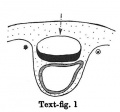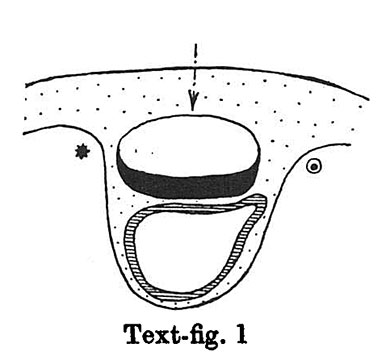File:Florian1930-text-fig01.jpg
Florian1930-text-fig01.jpg (384 × 359 pixels, file size: 19 KB, MIME type: image/jpeg)
Text-fig 8. Schemes of the chief stages in the development of the human embryo
(text-fig. 1) corresponds with the Peters embryo (1899; Grosser, 1913): the primitive streak primordium and the stalk are not yet present; the embryo is situated in a thickening of the chorionic mesoderm. The future limits of the stalk are designated by a ʘ and a *. The axis of that part of the chorionic mesoderm, which will be transformed into the stalk in the course of further development, is marked by an arrow: it is perpendicular to the middle of the embryonal plate. During the further development, the amniotic cavity and the yolk-sac enlarge so rapidly that the mesoderm covering them is not able to keep pace. Whilst in stage 1 (text-fig. 1) the mesoderm of the amnion and that covering the dorsal marginal part of the yolk-sac are similar in structure to the chorionic mesoderm,
Ectoderm black; entoderm lined horizontally, primitive streak vertically, head process and chorda plate obliquely. Mesoderm dotted. The axis of the connecting stalk is marked by an arrow. The limits of the connecting stalk are marked by * and ʘ, the limits of the umbilical stalk by + and ʘ). The direction of the extension of the amniotic cavity towards the connecting stalk is marked by arrows. The parts of the allantois and of the axis of the connecting stalk situated out of the median plane are finely dotted. A. Connecting stalk; B. umbilical stalk; Cl.m. cloacal membrane.
| Historic Disclaimer - information about historic embryology pages |
|---|
| Pages where the terms "Historic" (textbooks, papers, people, recommendations) appear on this site, and sections within pages where this disclaimer appears, indicate that the content and scientific understanding are specific to the time of publication. This means that while some scientific descriptions are still accurate, the terminology and interpretation of the developmental mechanisms reflect the understanding at the time of original publication and those of the preceding periods, these terms, interpretations and recommendations may not reflect our current scientific understanding. (More? Embryology History | Historic Embryology Papers) |
- Links: Text-fig 1 | Text-fig 2 | Text-fig 3 | Text-fig 4 | Text-fig 5 | Text-fig 6 | Text-fig 7 | Text-fig 1-7 | Text-fig 8 | Text-fig 9 | Text-fig 8-9 | Florian 1930 | Historic Embryology Papers
Reference
Florian J. The formation of the connecting stalk and the extension of the amniotic cavity towards the tissue of the connecting stalk in young human embryos. (1930) J. Anat., 64: 454-476.
Cite this page: Hill, M.A. (2024, April 27) Embryology Florian1930-text-fig01.jpg. Retrieved from https://embryology.med.unsw.edu.au/embryology/index.php/File:Florian1930-text-fig01.jpg
- © Dr Mark Hill 2024, UNSW Embryology ISBN: 978 0 7334 2609 4 - UNSW CRICOS Provider Code No. 00098G
File history
Click on a date/time to view the file as it appeared at that time.
| Date/Time | Thumbnail | Dimensions | User | Comment | |
|---|---|---|---|---|---|
| current | 18:58, 23 September 2015 |  | 384 × 359 (19 KB) | Z8600021 (talk | contribs) |
You cannot overwrite this file.
File usage
The following 3 pages use this file:

